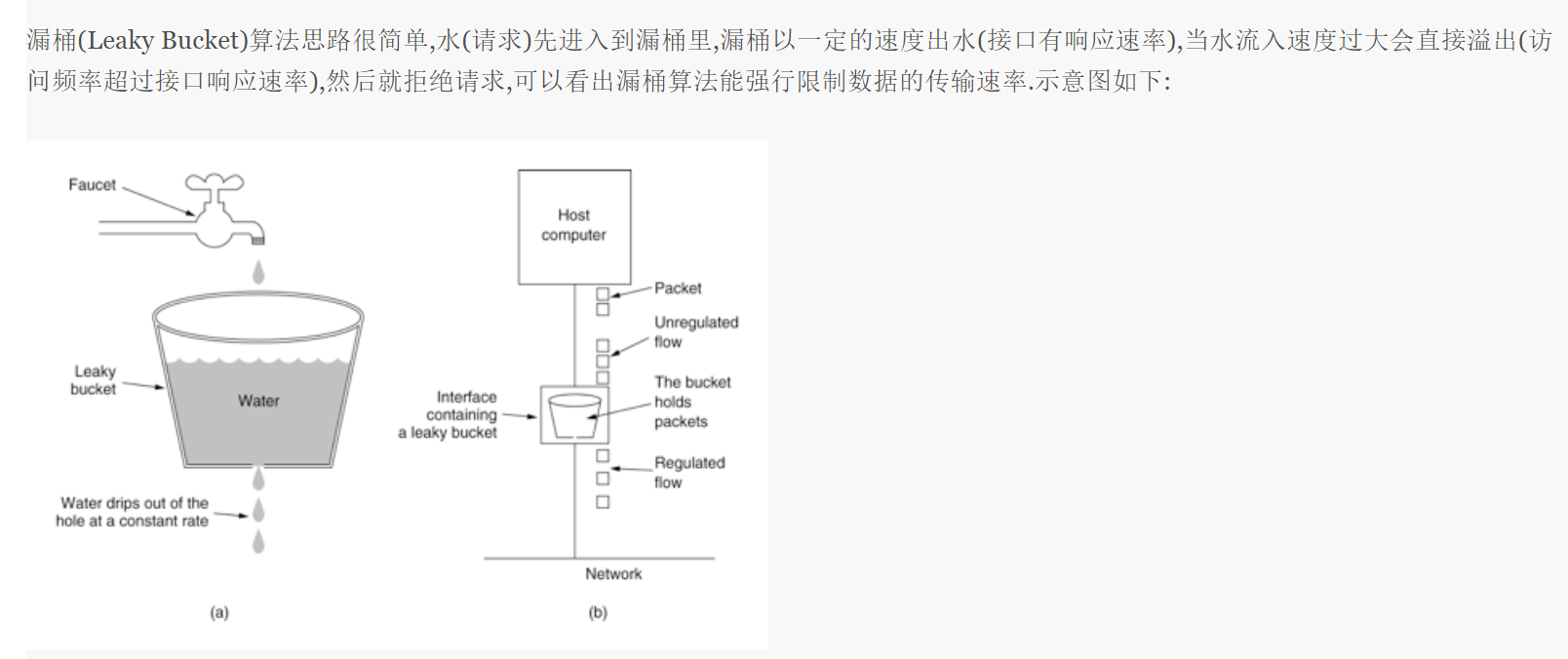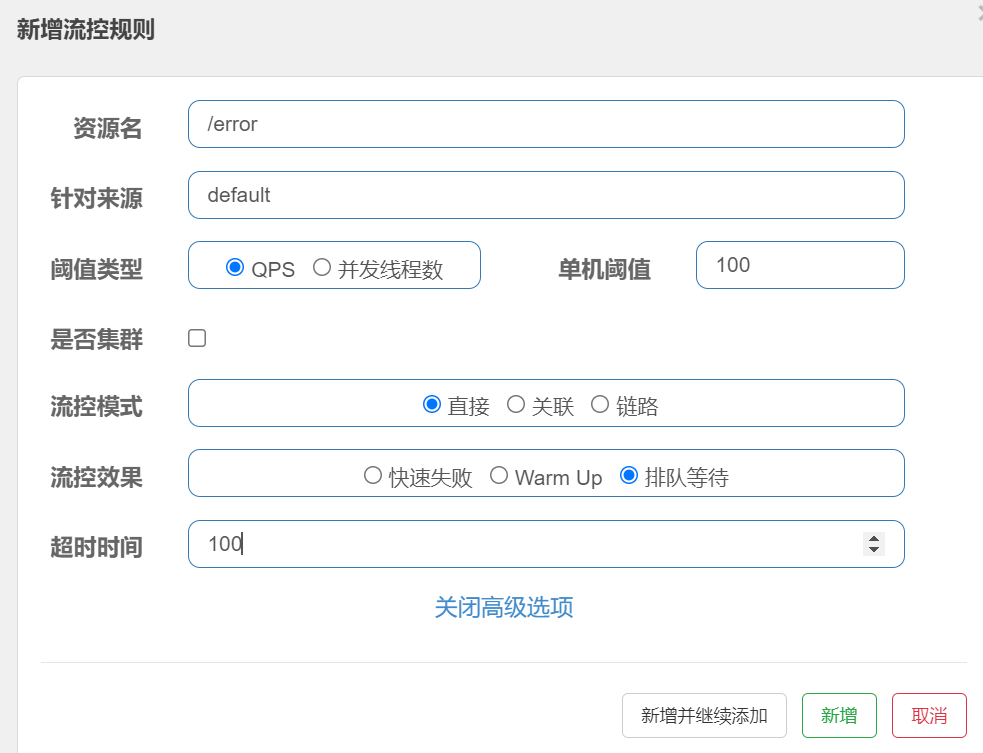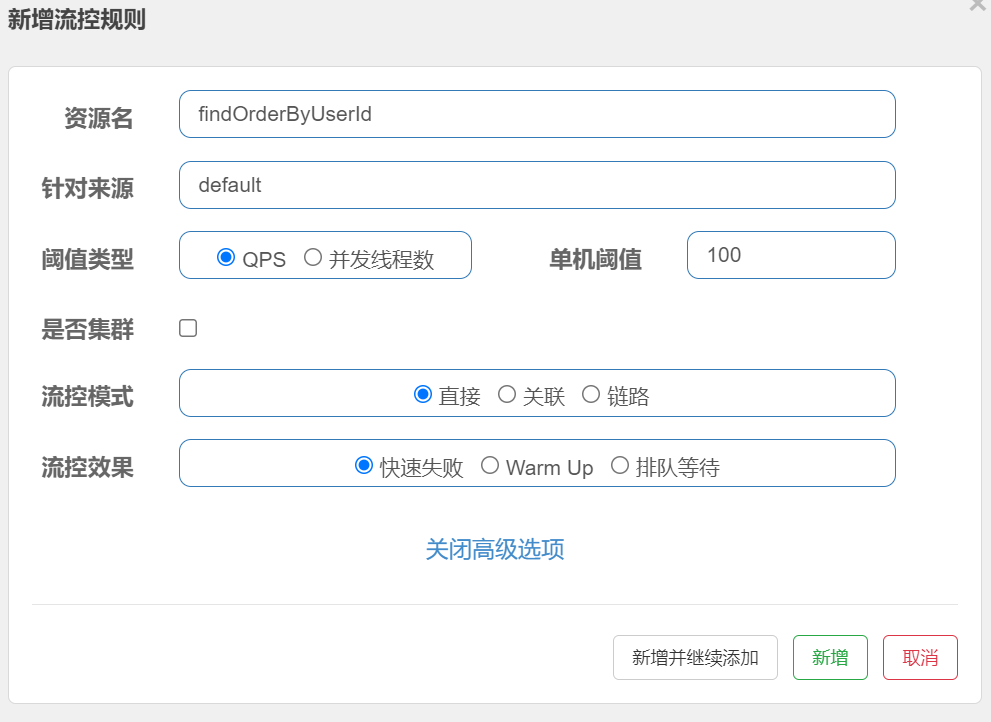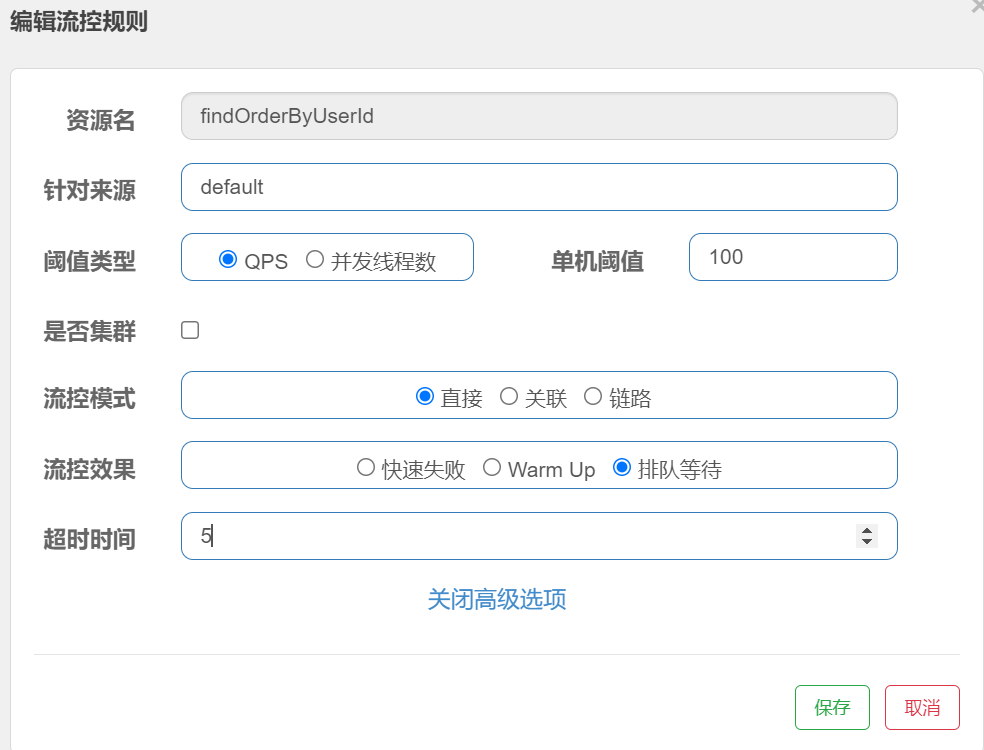Sentinel(三) 限流算法-漏桶算法
漏桶算法的介绍网上一大堆,摘取如下:

漏桶算法的伪代码如下:
public class LeakyBucket { // 当前桶的容量 当前累计的请求数 private int allWater; // 桶的阈值 private volatile AtomicInteger water; // 出水速率 每秒 rate private Long rate; private volatile long timeMillis = System.currentTimeMillis(); public boolean canPass() { long now = System.currentTimeMillis(); water.addAndGet((int) Math.max(0, water.get() - (now - timeMillis) / 1000 * rate)); timeMillis = now; if (water.incrementAndGet() < allWater) { return true; } else { water.decrementAndGet(); return false; } } }
漏桶算法是控制的是速率,让请求以一定的速率通过,所以它无法应对流量激增的情况。比如 配置的速率 100/s,那么相当于10ms 通过一个,10ms要是通过2个都不行。这个和滑动时间窗口的限流就有很大的区别了。
我们看下Sentinel中是怎么使用漏桶算法的。
页面上的流控配置对应:排队等待,Sentinel还提供了处理不了的时候有个等待时长。

看下具体的算法。
从前面的分析中知道了不同的分流算法会在FlowRuleChecker#passLocalCheck 根据不同的FlowRule走到不同的流控算法。这个流控效果是排队等待的rater对应
private static boolean passLocalCheck(FlowRule rule, Context context, DefaultNode node, int acquireCount, boolean prioritized) { Node selectedNode = selectNodeByRequesterAndStrategy(rule, context, node); if (selectedNode == null) { return true; } // 排队等待 算法对应RateLimiterController return rule.getRater().canPass(selectedNode, acquireCount, prioritized); }
public class RateLimiterController implements TrafficShapingController { private final int maxQueueingTimeMs; private final double count; private final AtomicLong latestPassedTime = new AtomicLong(-1); public RateLimiterController(int timeOut, double count) { // 超时时长 this.maxQueueingTimeMs = timeOut; // 速率 this.count = count; } @Override public boolean canPass(Node node, int acquireCount) { return canPass(node, acquireCount, false); } @Override public boolean canPass(Node node, int acquireCount, boolean prioritized) { // Pass when acquire count is less or equal than 0. if (acquireCount <= 0) { return true; } // Reject when count is less or equal than 0. // Otherwise,the costTime will be max of long and waitTime will overflow in some cases. if (count <= 0) { return false; } // 当前时间 long currentTime = TimeUtil.currentTimeMillis(); // Calculate the interval between every two requests. // 两个请求之间的间隔 就是页面配置的阈值换算成了毫秒单位 假如页面配置的单机阈值:100 这里的结果就是 10ms long costTime = Math.round(1.0 * (acquireCount) / count * 1000); // Expected pass time of this request. // 因为有了速率的限制 所以此次请求有一个规定的可以放行的时间 long expectedTime = costTime + latestPassedTime.get(); // 当前时间 大于等于 可以放行的时间 说明可以放行了 if (expectedTime <= currentTime) { // Contention may exist here, but it's okay. latestPassedTime.set(currentTime); return true; } else { // 当前时间 小于 可以放行的时间 说明暂时不可以放行 // Calculate the time to wait. // 上次请求的时间和当前时间都重新计算取了最新的 // 计算当前时间距离可以放行的时间 有多久 long waitTime = costTime + latestPassedTime.get() - TimeUtil.currentTimeMillis(); if (waitTime > maxQueueingTimeMs) { // 如果当前时间距离可以放行的时间 大于超时时长 则直接不放行 return false; } else { // 等待时长小于超时 时长 说明可以进入等待 // 再次计算下次可以执行的时间,注意这里是直接更新 latestPassedTime 的值 long oldTime = latestPassedTime.addAndGet(costTime); try { // 再次计算新的等待时长 因为 latestPassedTime 可能已经被改变了 waitTime = oldTime - TimeUtil.currentTimeMillis(); if (waitTime > maxQueueingTimeMs) { // 超时的话 还是是会被拒绝 然后时间回滚 latestPassedTime.addAndGet(-costTime); return false; } // in race condition waitTime may <= 0 if (waitTime > 0) { // 等待 休眠后放行 Thread.sleep(waitTime); } return true; } catch (InterruptedException e) { } } } return false; } }
这个算法看起来很简洁,这里主要控制请求可以放行的时间来控制放行的速率。我们可以对比下上篇使用的快速失败-滑动时间窗口,和这次的排队等待-漏桶算法的实时流量监控图形。
我们都设置qps 100
快速失败:

压测数据,200并发,0.5秒发起。循环1次。

从图形看出,时间滑动窗口限流,流量曲线是陡增的。

再来看下排队等待。

效果:看到1s内只通过十个,这个和计算出来的桶的流速是一致的10ms一个。流量图也是失败的线比成功的线高很多。

分类:
sentinel





【推荐】国内首个AI IDE,深度理解中文开发场景,立即下载体验Trae
【推荐】编程新体验,更懂你的AI,立即体验豆包MarsCode编程助手
【推荐】抖音旗下AI助手豆包,你的智能百科全书,全免费不限次数
【推荐】轻量又高性能的 SSH 工具 IShell:AI 加持,快人一步
· 震惊!C++程序真的从main开始吗?99%的程序员都答错了
· 【硬核科普】Trae如何「偷看」你的代码?零基础破解AI编程运行原理
· 单元测试从入门到精通
· 上周热点回顾(3.3-3.9)
· winform 绘制太阳,地球,月球 运作规律
2021-05-12 SpringMVC框架结合aven单独搭建